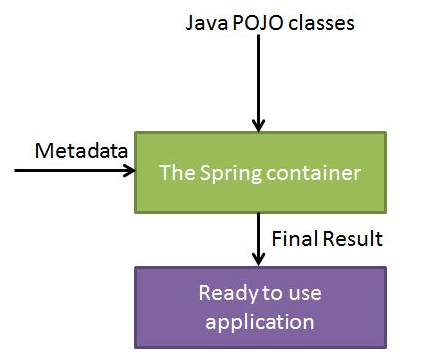- Spring
Spring
What is Sping Framework?
The Spring Framework is an open source application framework and IoC for the Java platform.
Spring is modular, allowing you to pick and choose which modules are applicable to you, without having to bring in the rest.
Sping Features
- D.I.
- Modular
- Spring MVC
- Spring AOP
Sping Topics
- Spring Annotation
- Spring JPA
- Spring Security
- Spring / RESTful Integration
- Spring / SOAP Integration
Sping Architecture

Dependency Injection
What is D.I.
“One or more dependencies (or services) are injected, or passed by reference, into a dependent object (or client) and are made part of the client’s state. The pattern separates the creation of a client’s dependencies from its own behavior.”
依赖注入模式,不是自己手动创建对象的实例,而是(统一)控制对象实例化的过程,然后传到需要用的地方。
Three types of D.I.
- Constructor injection
- Setter injection
- Interface injection
with Constructor Injection
Helper(Service service) {
this.service = service;
}
with Setter Injection
public void setService(Service service) {
this.service = service;
}
with Interface Injection
public interface ServiceSetter {
public void setService(Service service);
}
public class Helper implements ServiceSetter {
private Service service;
@Override
public void setService(Service service) {
this.service = service;
}
}
D.I. Advantages
降低了依赖和被依赖类型间的耦合
如下例子中,在Helper类里调用了Service类来做一些事情,如果Service类的实现变了,改了constructor的signature, 那么Helper类也需要做改动,写的UT也要改动,等等。但是如果用了DI的话就没有这个问题。
// without dependency injection, we have to use `new()` to initiate the object
public class Helper {
private ServiceExample service;
Helper() {
service = new ServiceExample(...);
}
public String doSomething() {
...
service.doSomething();
...
}
}
What is Spring D.I.
you do not create your objects but describe how they should be created (by configuration)
DI这个概念我们或多或少在平时写代码的时候早就运用了,只不过还是需要在程序某处用new()生成实例,然后传递到需要的地方。
Spring把这个单拿出来,在原有的基础上扩展了其功能。框架帮我们new()实例,我们只需要配置一下就好了。

The Spring IoC container will create the objects, wire them together, configure them, and manage their complete lifecycle from creation till destruction.
Types
- Spring ApplicationContext Container
- create the bean before calling getBean()
- Spring BeanFactory Container
- create the bean when calling getBean()
Bean Factory/Application Context

Creation of a bean
Two ways of create a bean factory and get bean
e.g. using BeanFactory
import org.springframework.beans.factory.BeanFactory;
import org.springframework.beans.factory.xml.XmlBeanFactory;
import org.springframework.core.io.FileSystemResource;
BeanFactory factory = new XmlBeanFactory(new FileSystemResource("spring.xml"));
Square square = (Square) factory.getBean("square");
e.g. using ApplicationContext
import org.springframework.context.ApplicationContext;
import org.springframework.context.support.ClassPathXmlApplicationContext;
ApplicationContext context = new ClassPathXmlApplicationContext("spring.xml");
Square square = (Square) context.getBean("square");
Difference between BeanFactory and ApplicaitonContext
BeanFactoryonly instantiates bean when you callgetBean()methodApplicationContextinstantiates Singleton bean when container is started, It doesn’t wait forgetBean()to be called
Injecting Fields/Objects/Colleciton
Spring using setter() to set class variables’ values
Fields
e.g. Square.java
private int height;
e.g. spring.xml
<bean id="square" class="com.chennanni.learnspring.Square">
<property name="height" value="10"/>
</bean>
Objects
e.g. Square.java
private Point pointA;
e.g. spring.xml
<bean id="square" class="com.chennanni.learnspring.Square">
<property name="pointA">
<bean class="com.chennanni.learnspring.Point">
<property name="x" value="1" />
<property name="y" value="1" />
</bean>
</property>
</bean>
Collection
<bean id="triangle" class="com.chennanni.learnspring.Triangle">
<property name="points">
<list>
<ref bean="Point1" />
<ref bean="Point2" />
</list>
</property>
</bean>
Using Constructor Injection
Spring passes values to the constructor method
e.g. Square.java
private String type;
private int height;
private Square (String type, int height) {
this.type = type;
this.setHeight(height);
}
e.g. spring.xml:
<bean id="square" class="com.chennanni.learnspring.Square">
<constructor-arg type="java.lang.String" index="0" value="type1" />
<constructor-arg type="int" index="1" value="10" />
<property name="type" value="type2" />
</bean>
Misc
ContextLoaderListener
When to use it: if you want to put your Servlet file in your custom location or with custom name, rather than the default name "[servlet-name]-servlet.xml" and path under "Web-INF/"
<context-param>
<param-name>contextConfigLocation</param-name>
<param-value>/MyLocation/myservlet-servlet.xml</param-value>
</context-param>
<listener>
<listener-class>org.springframework.web.context.ContextLoaderListener</listener-class>
</listener>
Purpose of ContextLoaderListener
- to tie the lifecycle of the
ApplicationContextto the lifecycle of theServletContext - to automate the creation of the
ApplicationContext
http://stackoverflow.com/questions/11815339/role-purpose-of-contextloaderlistener-in-spring
Other Topic
- [[aop]]
- [[bean]]
- [[boot]]
- [[cloud]]
- [[spring/jms/jms]]
- [[spring/jpa/jpa]]
- [[spring/txn/txn]]
Ref
- Spring全家桶:https://gitbook.cn/gitchat/column/5d2daffbb81adb3aa8cab878
